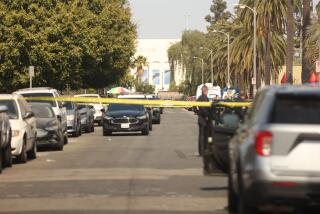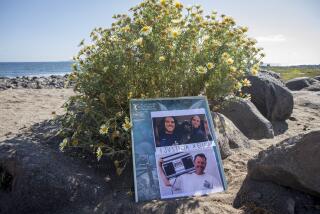DNA Points to Suspect in San Diego Boys’ 1993 Slayings
SAN DIEGO — Investigators using DNA data have identified a suspect in the high-profile case of two San Diego boys found strangled along the banks of the Otay River in 1993.
Law enforcement sources said the suspect is serving a lengthy prison sentence for sexual assault on a young woman.
The murders of Charles Keever, 13, and his best friend, Jonathan Sellers, 9, stunned the city’s San Ysidro community. Police said one of the victims was sexually assaulted. The two disappeared March 27, 1993, and were last seen buying hamburgers at a fast-food restaurant.
Their bodies were discovered two days later a few feet from their bicycles in an undeveloped area of marshy underbrush and trees near their homes. Family members said the boys were inseparable and liked to play at a makeshift fort on the wooded grounds.
Detectives interviewed about 20 transients who lived in an encampment underneath a bridge at the time, but it is unknown if the suspect was among them. Sources said that the man’s mother lived in Imperial Beach at the time of the murders.
The boys’ deaths stirred an outpouring of emotion in the city and police department. Then-Mayor Susan Golding closed a City Council meeting with a valediction to the boys. At one point, 10 detectives were assigned to the investigation full time.
Charles and Jonathan lived in an ethnically mixed community five miles north of the Mexican border and were good students.
They were active in sports, and because they rode their bikes everywhere the boys were familiar figures in the community. Mourners contributed thousands of dollars for their funeral and burial costs. Family members remembered the boys with a shrine that included their photos near the murder site.
After dozens of leads from tipsters, investigators found themselves no closer to solving the crime. Years passed without any progress in the investigation, making the case one of three high-profile child murders that remained unsolved in the county since 1989.
However, forensics experts did recover DNA evidence at the scene, which ultimately led to the alleged killer’s identity, sources said.
Police agencies increasingly are turning to DNA techniques to find suspects in crimes where biological evidence was found.
In some unsolved cases, including the boys’ slayings, the sample is compared to about 135,000 DNA profiles of convicted felons stored at the state’s DNA data bank in Berkeley, state Justice Department spokesman Mike Van Winkle said. The state began collecting samples in 1986 but didn’t begin analyzing the data until the technology was available in 1992.
Since 1994, the data bank has helped identify 29 suspects in unsolved crimes through “cold hits,” Van Winkle said. But the process of analyzing samples in the data bank is time-consuming, meaning many unsolved cases may take years to solve through DNA matching, he said.
More to Read
Sign up for Essential California
The most important California stories and recommendations in your inbox every morning.
You may occasionally receive promotional content from the Los Angeles Times.










